David Huertas
David is a very talented golfer from Bogota, Colombia who came to Somax complaining of loss of flexibility and low back pain. David played scratch golf as a junior (he started playing golf at age 4), but his play deteriorated two years after he started lifting weights at age 15. As we know, it takes about 1-2 years for the microfibers (scar tissue) created by weight lifting to accumulate to the point where they affect a golfer's flexibility and swing mechanics. By the age of 18, David was shooting in the 90's.
After completing his Somax program in July 2009, David increased his average drive from 290 to 350, was hitting 12-13 of 14 fairways, and dropped his index to 1.4. David was able to do this because he increased his Range (the number of degrees he turned away from the ball at the top of his backswing) while improving his Alignment (the number of degrees he changed his Spine Angle during his swing), Speed (the speed of his hips during his downswing) and Sequence (starting his downswing with his left knee).
Address—Front
Here are David's before and after photos from his Somax program. He now takes a wider stance at address in order to increase his stability while handling higher swing speeds. A wider stance also makes it easier for him to start his downswing with his left knee. Before his Somax program, David started his downswing with his hands. Now he starts with his left knee, then his hips, shoulders, arms, and then hands. This is a much more powerful, efficient swing sequence. His Front Spine Angle at address is now vertical. Before it was 8°. This improved Alignment helped to improve David's accuracy.
You can also see that David now tees up his ball in the center of his stance. This enables him to return his club at impact without shifting his weight toward the target. Shifting the weight is a very weak move and adds little or no distance. It does, however, force the golfer to change his Front Spine Angle at impact, which degrades his accuracy. Teeing up forward in your stance is just one of the many conventions that makes golf unnecessarily difficult.
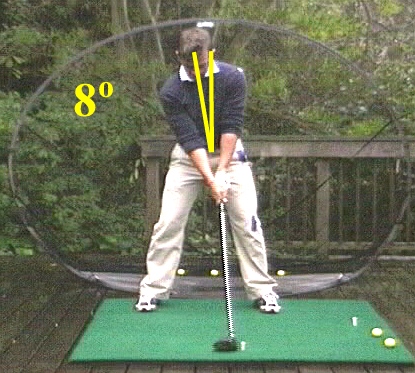
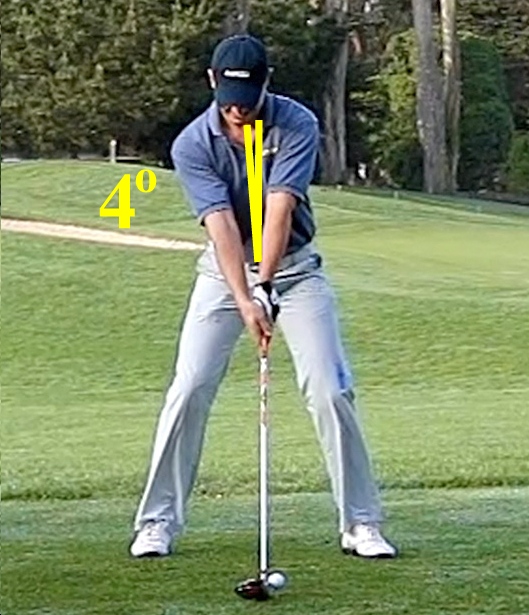
Front Spine Angle@Address Before Front Spine Angle@Address After
Backswing
After microfibers (scar tissue) were released from David's back and shoulders, he was able to increase his Arm Angle from 75° to 90° without any additional effort.
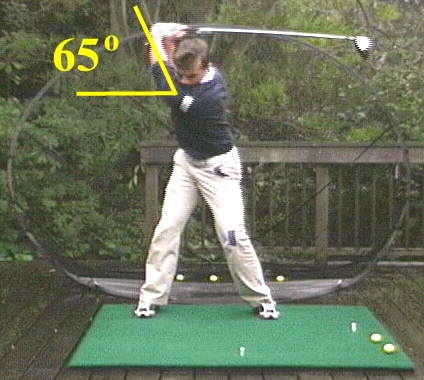
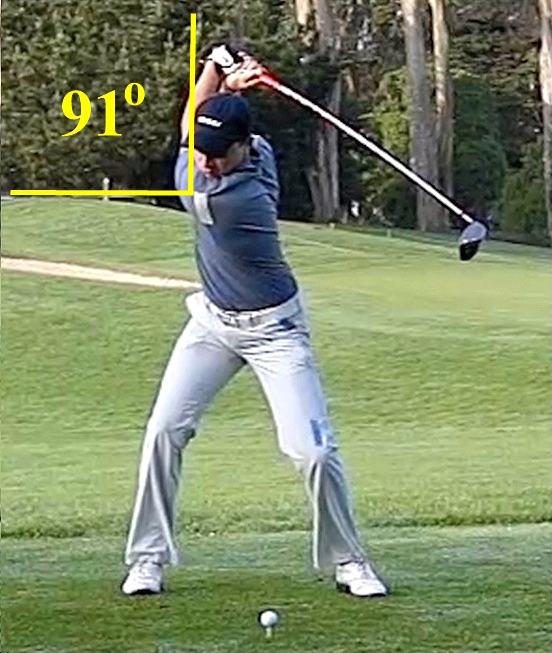
Arm Angle Before Arm Angle After
David was also able to increase his Shoulder Turn Angle from 100° to 120° after microfibers were released in his back and hips. This huge Shoulder Turn Angle and his faster hip speed allow David (who is only 5'10" and 160 lbs.) to hit 350+ yard drives. The only golfer we have measured with a larger Shoulder Turn Angle was Sam Snead, with 140°. Snead won the most professional tournaments in the history of golf.
These increases in Range helped David increase his distance without any additional effort. The more you can turn away from the ball (Range), the more time your hands and club can get up to speed at impact. Restricting the backswing only adds stress to the body. It does not increase accuracy, which is increased by improving Alignment.
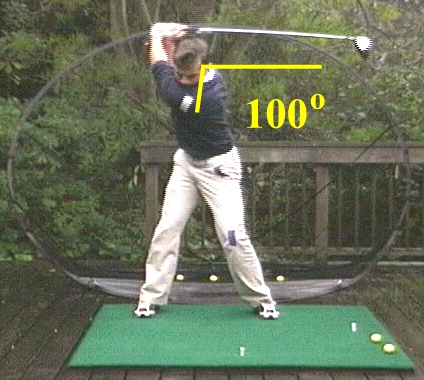
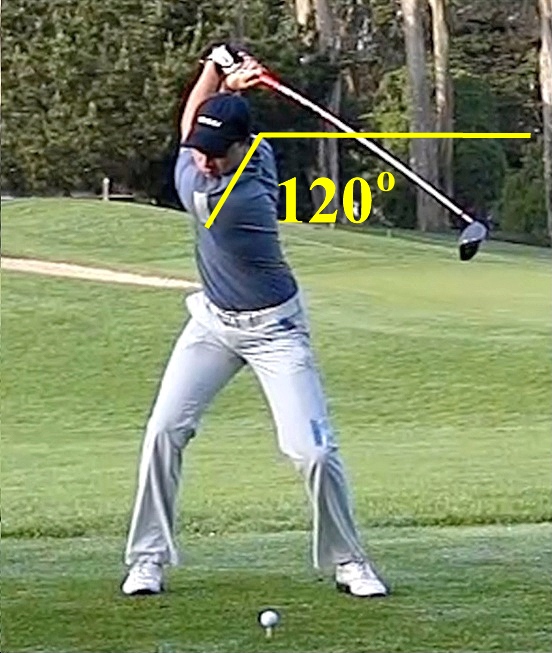
Shoulder Turn Angle Before Shoulder Turn Angle After
Downswing
The Cast Point is that point during the downswing when your left arm is 45° below horizontal, or about even with your hips. We estimate how many degrees a golfer has opened his hips at this point as an indication of hip speed. For an efficient swing, you want a minimum of 45°. Here is David's Hip Rotation Angle at Cast Point before and after his Somax Program. David has increased his Hip Rotation Angle from 10° to 45°, a 450% increase. You can also see that he is now more aggressive with his left knee on his downswing. Increasing his hip speed has helped David increase his distance.
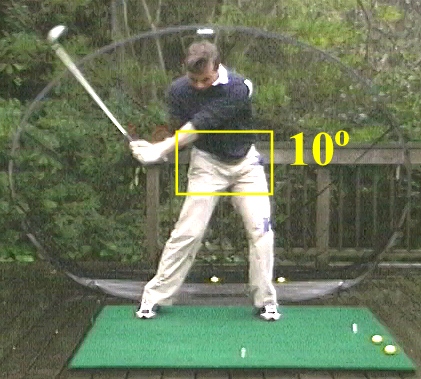
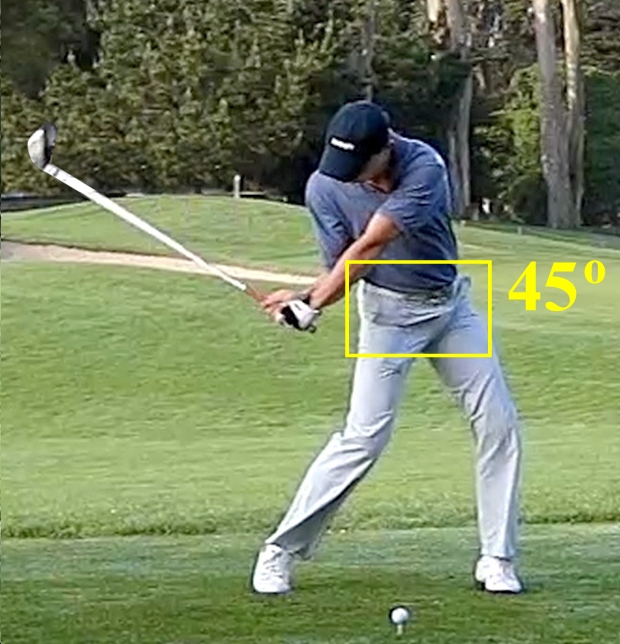
Hip Rotation Angle Before Hip Rotation Angle After
Impact
After we increased David’s Internal Hip Rotation (see below) by releasing microfibers around his hips (which eliminated his back pain), we then taught him to start his downswing with his left knee, instead of shifting his hips toward the target as is commonly taught. This started the opening of his hips early in his downswing. After training on our Power Hip Trainer, David learned to drive his right hip much farther open, vastly increasing his hip speed.
You can see the result in the photos above at Cast Point, and especially in the photos below at impact. Because of his much greater hip speed, David’s hips went from 20º open at impact to 60º open at impact in just four weeks—a 300% improvement. This added hip speed helped propel his average drive from 290 to 350. But because his alignment was also improved, and the extra clubhead speed came from his legs and hips (and not by extra effort with his arms) David also increased his fairway percentage from 55% of his fairways at 290 yards to 92% of his fairways at 350 yards!
David's improvement in Range (how far he is able to turn away from the ball), Alignment and Hip Speed shows that it is possible to hit the ball much farther and more accurately with less effort by improving all these components of the swing in one Somax program.
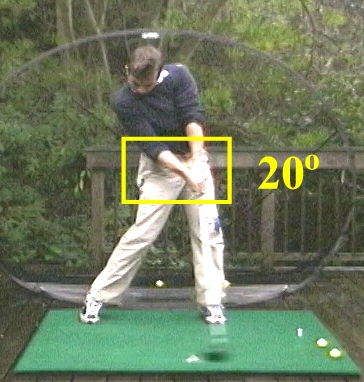
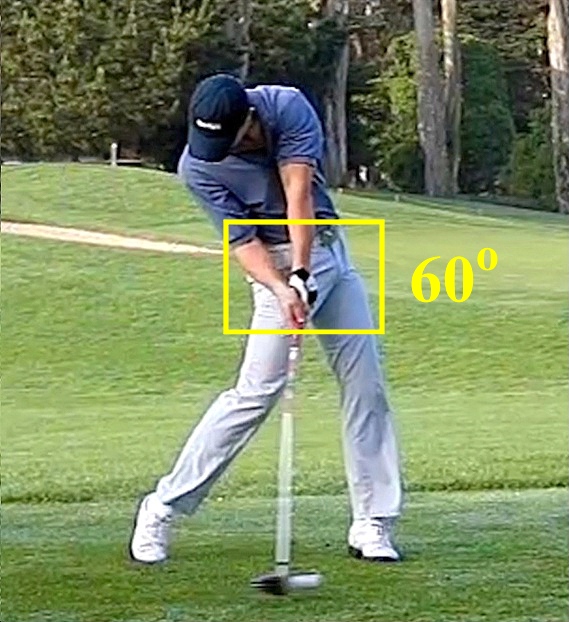
Front Spine Angle @ Impact Before Front Spine Angle @ Impact After
Address-Down the Line
From down the line, David now has his hands on his swing plane at address. This will enable him to maintain his Spine Angle during his swing, resulting in more accurate ball striking. This is another reason he is now capable of 350+ yard drives that land in the fairway. Both Front Spine Angle and the Spine Angle should be as constant as possible from address to impact in order to improve Alignment, and therefore accuracy.
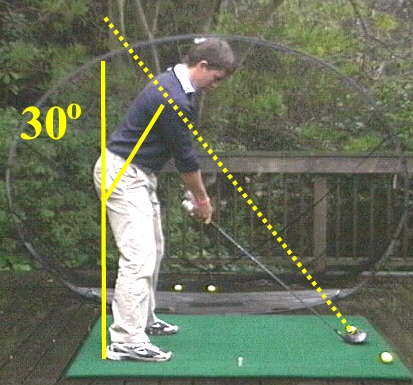
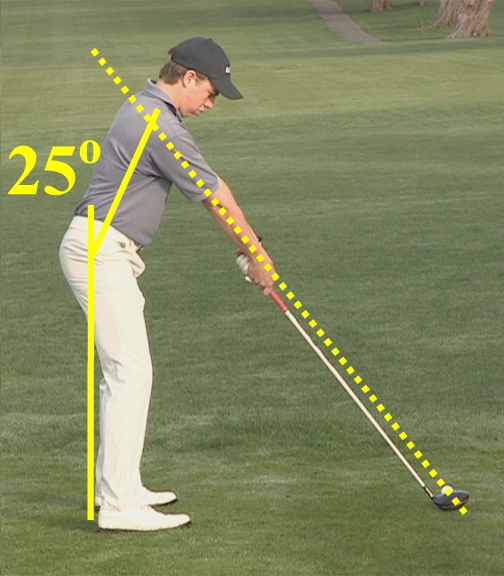
Spine Angle @ Address Before Spine Angle @ Address After
Impact
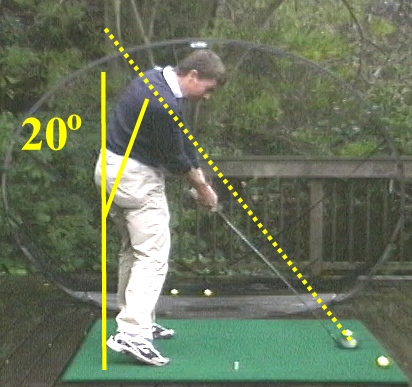
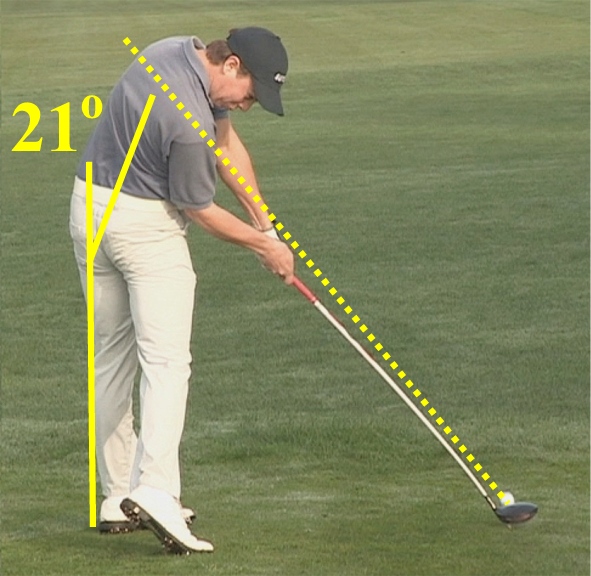
Spine Angle @ Impact Before Spine Angle @ Impact After
Before his Somax program, David changed his spine angle from 30° to 20° from address to impact, a change of 33%. Changing your spine angle this much makes it very difficult to maintain ball contact with the center of the clubface because your upper body is moving so much between address and impact. After his Somax program, he changed his spine from 25° to just 21°, a change of only 16%, or half of what it was before. This increased his ability to make ball contact with the center of the clubface, improving his accuracy and distance at the same time.
Flexibility
Like many other golfers, David thought that lifting weights would improve his golf game. Little did he realize that weight lifting tears the tens of thousands of tiny, individual muscle fibers that make up each one of our 600 muscles. This tearing triggers the formation of scar tissue within and around the muscles as part of the healing process. Unfortunately, this scar tissue (microfibrosis) continues to accumulate over time, making golfers stiffer over time. This is what happened to David. Instead of seeing his game improve, it got much worse. Like many other weight lifters, David also developed low back pain that never responded to conventional treatment or therapy. Years of stretching did not improve his flexibility at all.
Neck Rotation is critical to the golf swing, as the golfer has to look back over his left shoulder at the top of his backswing. If his neck is tight, the bridge of his nose will block his vision of the ball in his right eye, destroying stereoscopic vision. This will reduce his accuracy. In order to maintain accuracy, he may restrict his backswing and distance so that he can keep both eyes on the ball. David increased his neck rotation 50% at Somax.
Neck flexibility is also critical to putting accuracy. If the neck is stiff, the motion of the shoulders during the putt will move the head, resulting in an off-center hit.
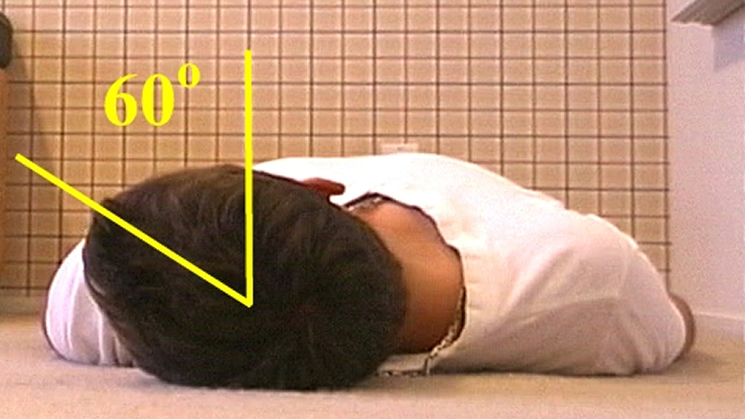
Before Somax

After Somax
Arm Flexion determines how many degrees you can turn your upper left arm away from the ball during your backswing. David increased his Arm Flexion 25°, or 38% with Somax. He was not able to get any improvement in this range with years of stretching.
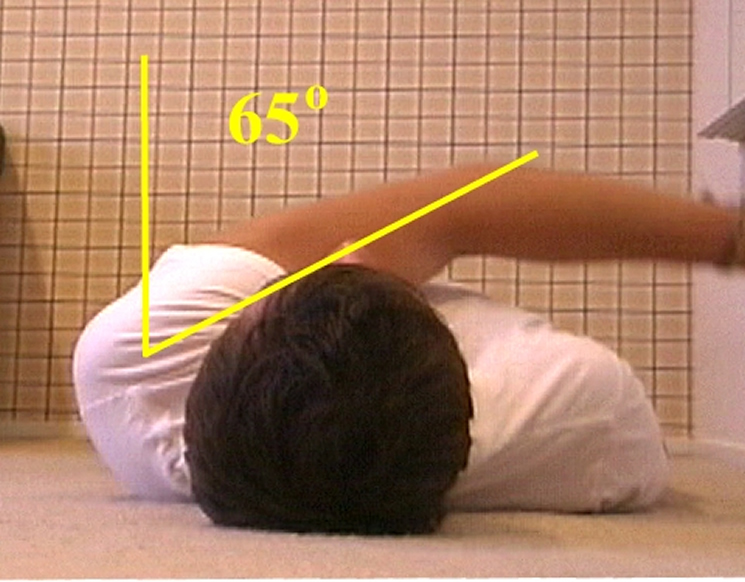
Before Somax
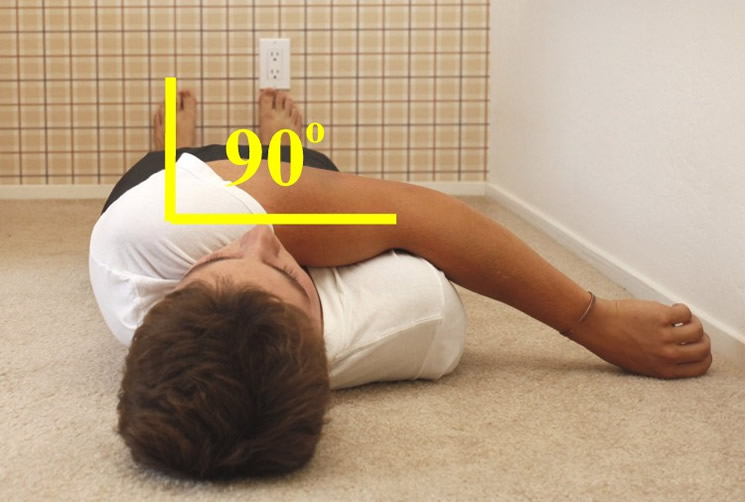
After Somax
External Hip Rotation is important for hip speed and range of movement of the hips during the swing. David increased his External Hip Rotation about 20° on each side, an improvement of 36% beyond what he was able to get from stretching alone.
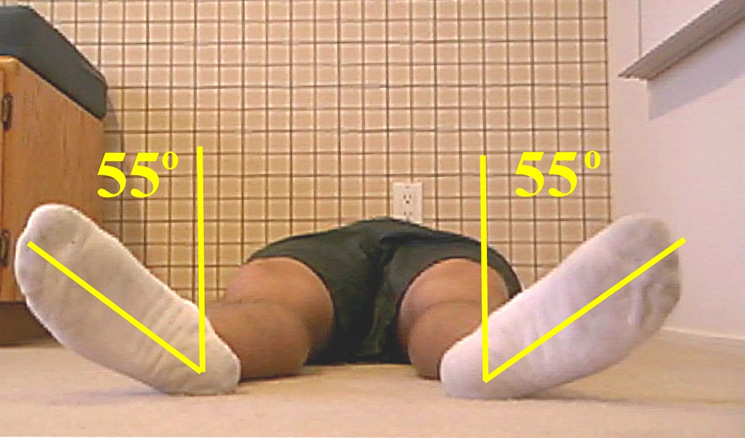
Before Somax
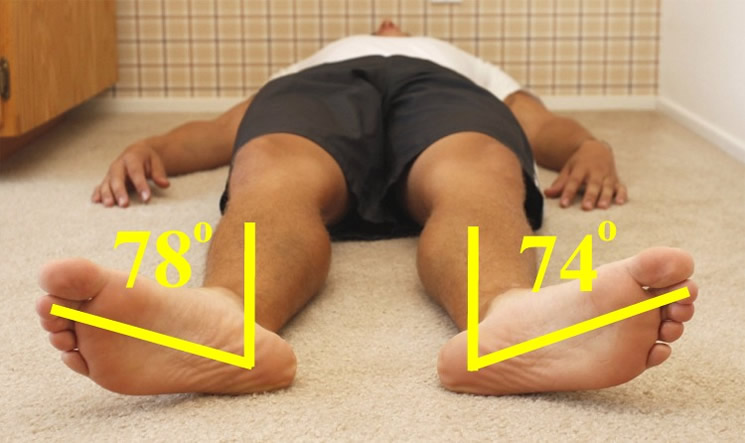
After Somax
Internal Hip Rotation is the most critical range for golf. It determines how far and fast your can rotate your hips during your swing. Hip rotation is the major source of power for the golf swing. After his Somax program, David was able to rotate his hips 26 times in 10 seconds on the Power Hip Trainer, the fastest hip rotation we have ever recorded.
Before his Somax program, David's lead hip was tighter than his trailing hip. Research conducted at the Buick Classic found that pro golfers with a history of low back pain had significantly less internal hip rotation on their lead hip than golfers who were free of back pain. When the lead hip is tight, it prematurely stops rotating after impact, while the upper body continues to turn while holding onto a club that is traveling at 100+ mph. This places tremendous stress on the lower back. Increasing the flexibility of his lead hip has allowed David to swing the club without straining his back.
Prior to coming to Somax, David was not able to get any improvement in his flexibility after lifting weights, despite several years of stretching.
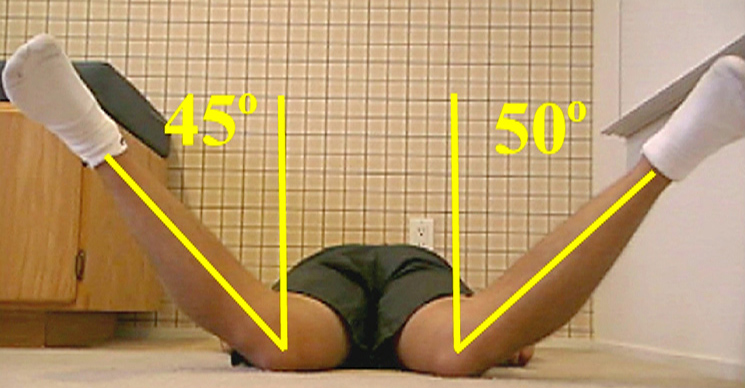
Before Somax
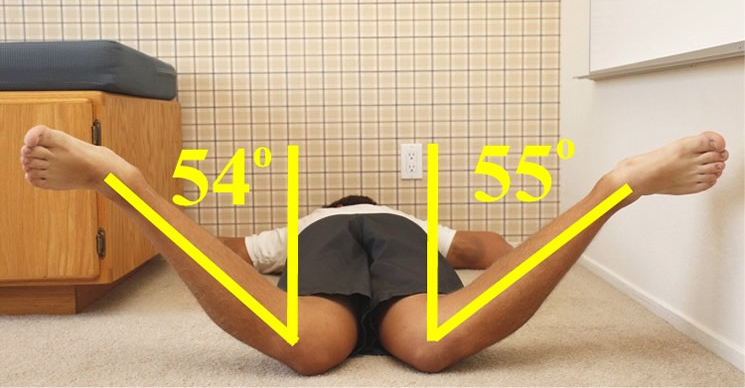
After Somax
Hip Extension is also critical to the low back. When hip extension is restricted, the pelvis is pulled forward and down, which creates a sway back or lordosis. The back muscles then have to chronically contract whenever the golfer stands erect, and even more so at address. Increasing David's hip extension allowed his pelvis to assume a level position, reducing the daily strain on his lower back as his back muscles relaxed. David's hip extension increased from 28° to 45°, an increase of 61%. This range had also not improved with stretching prior to his Somax program.
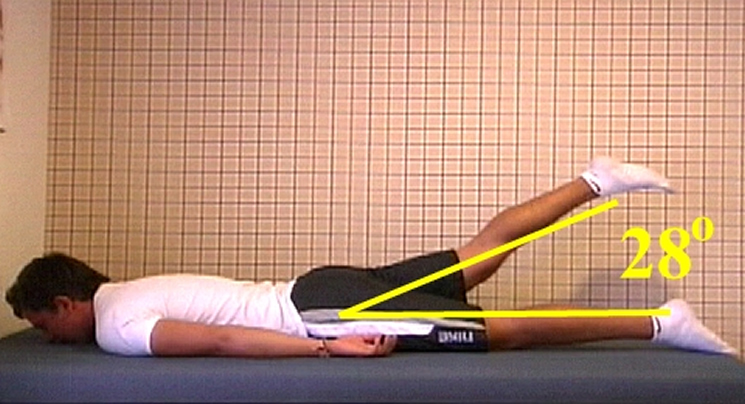
Before Somax
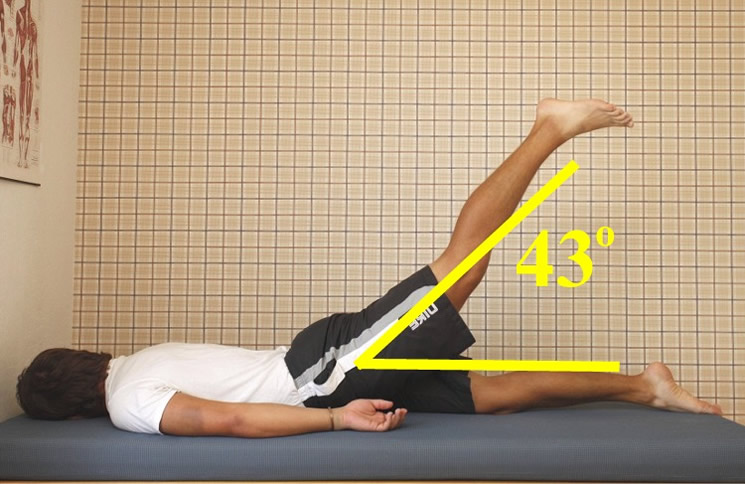
After Somax
Tight hamstrings also aggravate the lower back. David increased his Hamstring Range from 84° to 95°, an increase of 13%. As a result of the increases in internal hip rotation, hip extension and hamstring flexibility, David is no longer troubled by chronic low back pain.
Conventional treatment of low back pain is most often centered on treating pathology in the low back, such as bulging or herniated discs or inflamed facet joints. Measuring range of motion throughout the entire body has shown us that while golfers feel that their low back is stiff, it actually has more movement than their hips or middle back. Because of these restrictions above and below the lower back, the stress of the golf swing and daily movement is concentrated in the lower back. It then becomes inflamed and painful from overuse. By increasing flexibility above and below the lower back, our golfers spread the stress of movement over a much larger area, reducing the strain on their low back. Because there is less stress and strain, inflammation and spasm are reduced and the back can return to a pain-free state.
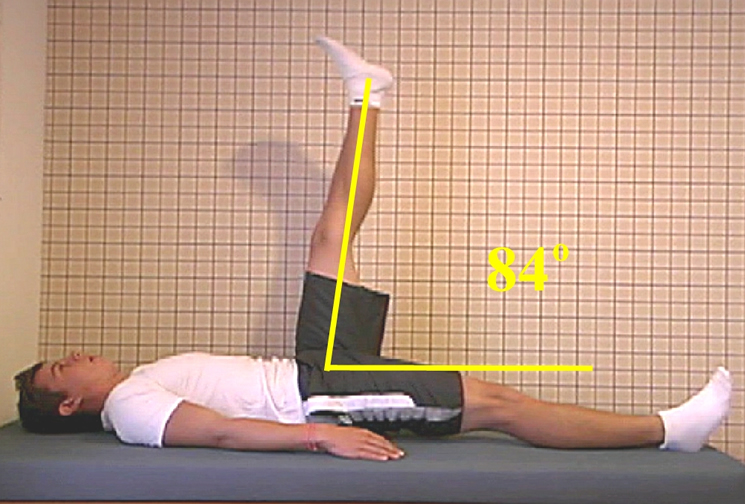
Somax Before
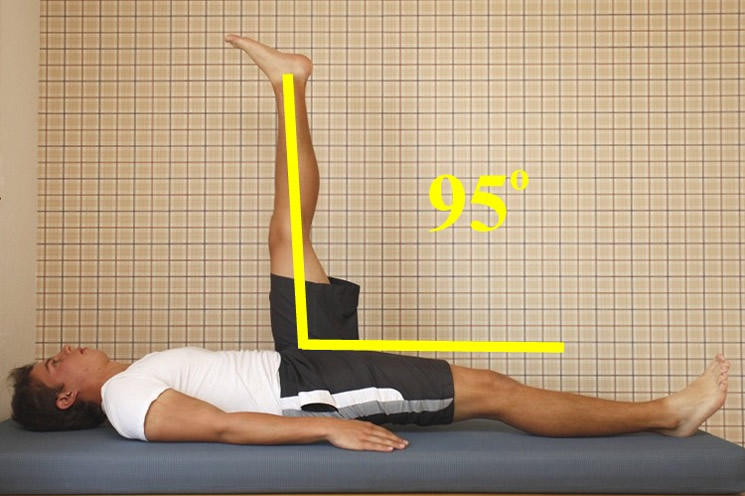
Somax After
The adductors are muscles located on the inside of the thigh. Their function is to bring the knees together. They oppose the movement of the left knee toward the target at the beginning of the downswing. As a result, golfers with tight adductors are more likely to shift their hips rather than rotate them during the golf swing. Shifting the hips toward the target is a very weak move and generates little or no club head speed. But it does increase the Front Spine Angle, making the golfer less accurate. Increasing the Adductor Angle in a golfer makes it easier for him to aggressively use his legs during the downswing, adding distance and accuracy to his swing.
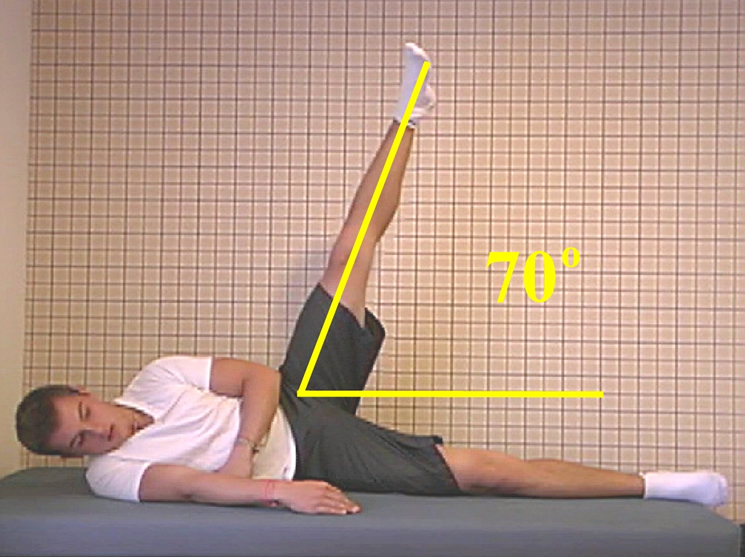
Somax Before
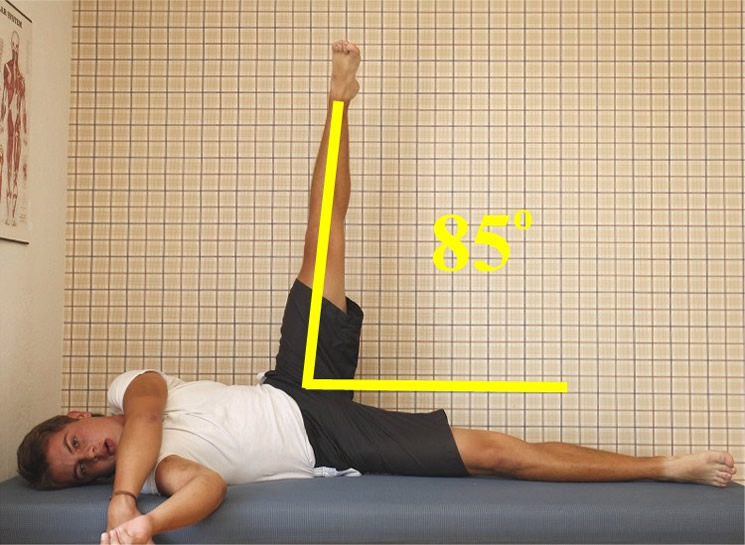
Somax After
Breathing
Many golfers hold their breath during their golf swing. This creates resistance to their backswing. David was one of these golfers. From years of doing sit-ups, microfibers constricted the movement of his abdomen and chest to the point where he could only expand 1" in his abdomen and 2" in his chest when he took a deep breath. He chronically held his breath during his swing, which is common in golfers with restricted breathing ranges.
By releasing microfibers that had formed from years of sit-ups, Somax was able to expand David's range of motion while breathing to 3" in his abdomen, an increase of 300%. Somax also increased his range of motion in his chest to 4", an increase of 200%. As a result, David no longer holds his breath during his golf swing.
Increasing the range of motion during breathing has other benefits. The brain runs on just oxygen and glucose (sugar). When the breathing is restricted, the brain does not get the oxygen it needs. Golfers who increase their breathing range at Somax report a better mood and increased ability to concentrate. Young golfers report that their school grades improve and older golfers find than their memory and problem-solving ability improve as well.
Microfibers
Golfers lose flexibility because microfibers (a mild form of scar tissue) have developed in the connective tissue between their muscles, binding them together. Because they are scar tissue, microfibers cannot be released by stretching.
 |
Normally, the connective tissue membranes (white) between the muscles (red) are smooth. They allow the muscles to slide past each other, which they have to do in order to stretch. But when you have even a mild injury (falls, sliding into base), overuse (lifting weights, running) or stress , microfibers form as part of the healing process to immobilize the area. Microfibers are nature’s internal cast. Unfortunately, once the area has healed, the microfibers not only do not go away, they tend to accumulate over time, making athletes stiffer with age. |
Golfers who have developed microfibers find that stretching does not improve their flexibility. Because they are unaware of that microfibers have formed in their connective tissue (usually as a result of playing sports when young, running or lifting weights and doing sit-ups, push-ups and pull-ups), they tend to blame themselves for any lack of improvement from stretching.
Somax releases these microfibers with Microfiber Reduction. As you can see here, and from David's photos above, Microfiber Reduction improves flexibility far beyond what stretching alone can do.
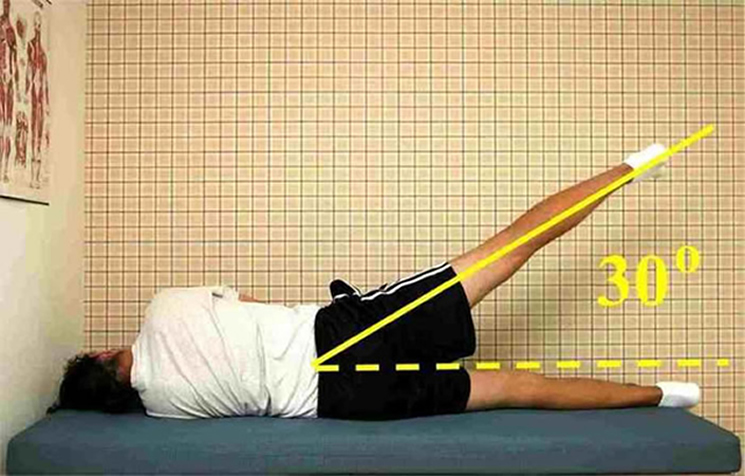
Before Microfiber Reduction
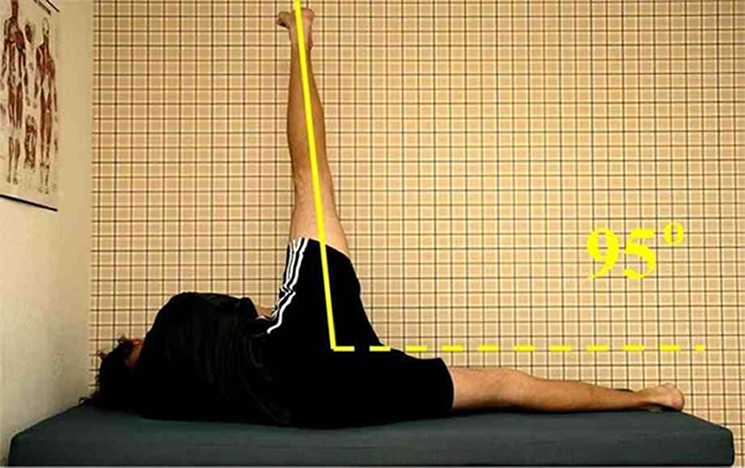
After Microfiber Reduction
David writes:
"As you know, I started playing golf when I was four years old. My father is a golf instructor in Colombia, and I was one of the top junior golfers in my country.
About four years ago I started lifting weights to improve my game. In part, I was imitating Camilo Villegas, a Colombian golfer who also lifted weights and now plays on the PGA Tour. I thought that if it helped him, lifting weights would help me as well.
Weights were a key ingredient for my golf training, and my idea of golf as a sport was directly connected with weights. After several years of lifting weights, my game was getting worse instead of better. From being in the top rankings of my country, I started to fall to the bottom. I couldn't understand what was happening.
My family started to invest in top elite golf academies in the US, which, instead of bringing me confidence and a better game, I just played worse and I started to doubt myself. One of the main problems was that I developed a severe left hook with my irons. I even worked for hours with mental coaches, thinking it was a mental problem.
My dad found Somax in the Internet and told me I should go to see if they could help me. So I came to Somax for an evaluation. You analyzed my swing and flexibility and explained what was happening to my golf game. I had been lifting weight for more than four years thinking it was the right thing to do. But actually it was restricting my body and my ability to swing the golf club.
You explained that lifting weights tears individual muscle fibers within the muscles. These microfibers accumulate over a couple of years and you progressively lose flexibility. When you started to release my microfibers, my flexibility came back immediately. The feeling and the performance were back too!
My left hook got better after microfibers were released in my stomach muscles (obliques) that had formed from doing lots of sit-ups and core work. It finally went away completely when you released microfibers in my shoulders that started from doing dumbbell flys.
I now understand the great damage weights have done to my performance overall and that my flexibility is a key part of my game. In a recent tournament, I was back to shooting eagles, birdies and pars. It feels like I have my life back again, instead of living in a state of constant frustration over my golf game. Also, with the increased flexibility and change in my swing mechanics taught to me at Somax (hands on swing plane, starting my downswing with left knee instead of left hip), I'm hitting my driver 350 yards and my clubs are all straight.
I also developed low back pain after lifting weights, and now that is gone.
Thank you for making me believe in myself again."
For More Information
Golfers who want to improve their distance and accuracy should measure their golf ranges to see if they have any restrictions—before assuming their problems in golf are mental.
Directions for measuring these ranges and a demonstration DVD showing how quickly Microfiber Reduction improves the flexibility of a 52 year-old can be ordered for $30 by calling Somax Performance Institute at 1-800-227-76629.
You can see additional before and after photos of our golf clients here.
Fees for our programs can be found here.
